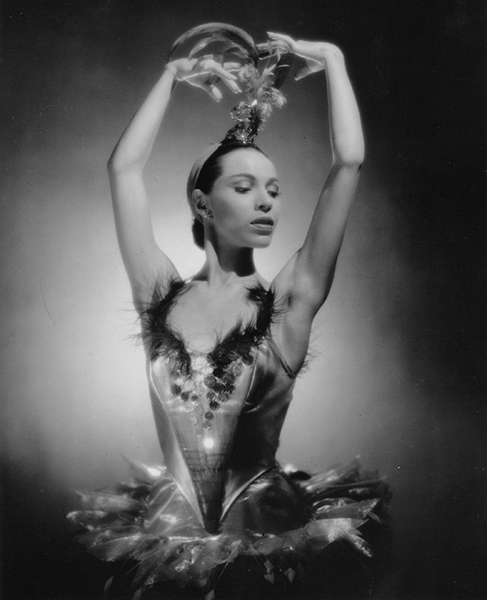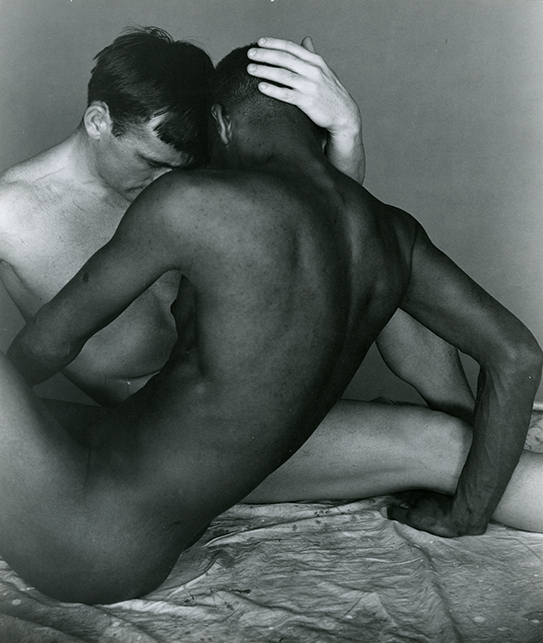Sensual/Sexual/Social: The Photography of George Platt Lynes
Discover one of the most influential fashion and portrait photographers of the 20th century
Opens at the Indianapolis Museum of Art at Newfields on September 30

Sensual/Sexual/Social: The Photography of George Platt Lynes runs from September 30 through February 24, 2019 at the Indianapolis Museum of Art at Newfields.
Related Events:
Explore the artistic legacy of renowned American photographer George Platt Lynes through this exhibition of photographs from the collection of the Kinsey Institute, Indiana University.
Lynes’ visionary work catapulted him to notoriety as a New York-based commercial fashion and ballet photographer, but he drifted from the spotlight when it was revealed that he also photographed male nudes. Lynes also turned his lens on his social circle, many of the artistic and literary minds of the mid-20th century, who accepted him as a gay man during a period of harsh anti-LGBT oppression in America.
“This timely exhibition explores the life of an artist who was marginalized by society for being gay and places him where he should be, at the forefront of the history of photography, alongside his more famous peers,” said Dr. Charles L. Venable, The Melvin & Bren Simon Director and CEO. “We at Newfields are passionately driven by efforts like this that add context and depth to art and the world we live in today.”
George Platt Lynes (1907-1955) grew up in New Jersey and attended boarding school in western Massachusetts where he first met Lincoln Kirstein, who later co-founded the New York City Ballet. In the early 1920s, Lynes traveled to Paris where he connected with members of the Parisian avant-garde, including the couple Gertrude Stein and Alice B. Toklas, who welcomed him into their social circle. During this time Lynes started to photograph his new friends and their shared life experiences.
After returning to the United States in the late 1920s, Lynes inherited a friend’s photographic equipment, which inspired him to spend more time photographing. Many important figures in the art world, several of whom were his close friends, agreed to sit for portraits including artists Paul Cadmus, Pavel Tchelitchew and Marc Chagall.
In 1935, Lynes became the first photographer for the American Ballet, later renamed the New York City Ballet, and remained their primary photographer for 20 years. The photographs that resulted from the personal and professional relationship between Lynes and Lincoln Kirstein are considered some of the finest ballet photographs ever made. Lynes was passionate about beauty and refinement and proved to be incredibly skillful at documenting dancers’ bodies in light and space.

The following year, Lynes was invited to participate in the Museum of Modern Art’s exhibition, Fantastic Art, Dada, and Surrealism. His surrealist photograph, The Sleepwalker, was exhibited alongside his peers and fellow modern masters, such as Salvador Dali, Max Ernst and René Magritte.
Lynes was a rising star in New York City’s photography scene, celebrated for both his fine art and commercial work. He photographed for renowned fashion magazines such as Vogue and Harper’s Bazaar and created ad campaigns for Barneys and Henri Bendel. As a Vogue photographer, Lynes had the opportunity to create portraits of numerous writers and performers, including author/entertainer Kay Thompson (creator of the Eloise children’s books) and playwright Tennessee Williams.
During a time of restricted societal norms and repression of homosexuality, Lynes and his gay friends created a tight-knit community where they could express themselves. Support from this community allowed Lynes to explore his interest in the male nude as a photographic subject, something that was considered radical, as the female body was generally the only acceptable subject in the nude at this time. When Lynes began photographing nudes in the 1930s, he understood how the male form had historically been represented in fine art. His interest in Greek classical representations of the male body grounded these photographs and presented the male form as beautiful and desirable.
Lynes was fully aware of the personal risk he took during this time and took measures to protect the identity of his subjects and body of work. Outside of the relative safety of his social circle in New York City, the country was not a safe place to live life as a gay man or to be a male nude model. Lynes and the men who modeled for him took considerable risks to produce these photographs during a period when those who engaged in perceived gay activities, like male nude photography, risked imprisonment and rejection from mainstream society.
In the late 1940s, Dr. Alfred Kinsey was working on his 1948 book Sexual Behavior in the Human Male at Indiana University, in Bloomington, Indiana. Kinsey was in the process of building his research institute and its art collection and wanted examples of the male nude, particularly photographs that illuminated gay lifestyles. It was Lynes’ nuanced photographs of the male form that brought the artist and Kinsey together. Kinsey was a crucial supporter of Lynes and the two men coordinated the donation of many of Lynes’ photographs and negatives to the Kinsey Institute.
The simple act of sending the photographs and negatives to Indiana from New York City was extremely risky. At this time, the law prohibited sending materials deemed obscene through the United States Postal Service. Kinsey and Lynes took extreme measures to ensure that his male nude photographs in particular were not transferred through the USPS by arranging numerous cross-country trips. The transfer of photographs to Indiana was successful and Lynes’ legacy and work has been preserved at the Kinsey Institute for nearly 70 years.
“We are excited to be working with an esteemed institution like Newfields to share the work of this wonderful artist, George Platt Lynes,” said Dr. Sue Carter, Kinsey Institute Director. “The Kinsey Institute Special Collections preserve art and artifacts that document the richness and variation of human sexual expression and relationships. Collaborations like this allow us to bring wider visibility to those artistic voices and life experiences that might otherwise be lost to history.”
Title image credit: George Platt Lynes (American, 1907–1955), Name Withheld, 1952, gelatin silver print, 8 × 10 in. From the Collections of the Kinsey Institute, Indiana University. © Estate of George Platt Lynes.

About the Exhibition
Sensual/Sexual/Social: The Photography of George Platt Lynes is on view in the Allen Whitehill Clowes Special Exhibition Gallery from September 30, 2018 through February 24, 2019.
In the exhibition, guests are invited to explore Lynes’ personal and professional life through a multi-layered timeline. Midway through the experience, guests can learn about the large format printing process by viewing a 200 sq. ft. studio recreation, play a photo negative game, watch a step-by-step video and touch vintage darkroom tools. Guests will also have the opportunity to listen to a narration of the letters Alfred Kinsey and George Platt Lynes exchanged and craft their own letter using a typewriter.
Sensual/Sexual/Social: The Photography of George Platt Lynes is curated by Rebecca Fasman, of the Kinsey Institute, and Robin Lawrence and Anne M. Young of Newfields. Prior to Newfields, Young was the photographic archivist at the Kinsey Institute and worked on digitizing and condition reporting their collection of more than 2,300 George Platt Lynes vintage negatives.
Organized by the Indianapolis Museum of Art at Newfields and the Kinsey Institute, Indiana University. Support for this exhibition is provided by the Robert Mapplethorpe Foundation. Framing support for this exhibition is provided by The Great Frame Up. Studio photography equipment is provided by Roberts Camera.
###
About the Kinsey Institute
For 70 years, the Kinsey Institute at Indiana University has been a trusted source for scientific information on sexuality, gender, sexual health, and reproduction. As a premier sex research institute, we fulfill our mission to foster and promote a greater understanding of human sexuality and relationships through research, education and public outreach. The Kinsey Institute Special Collections also offer researchers and students access to thousands of sexuality-related art and artifacts for study.
For more information, visit kinseyinstitute.org or contact kinsey@indiana.edu.
About Newfields
Newfields offers dynamic experiences with art and nature for guests of all ages. The 152-acre cultural campus features art galleries, lush gardens, a historic home, performance spaces, a nature preserve and sculpture park. From inspiring exhibitions in the IMA Galleries, to concerts in The Toby, to a stroll through The Garden with a glass of something cold, guests are invited to interact with art and nature in exciting new ways. Newfields is home to the Indianapolis Museum of Art, among the ten largest and ten oldest general art museums in the nation; the Lilly House, a National Historic Landmark; The Garden, featuring 40 acres of contemporary and historic gardens, a working greenhouse and an orchard; and The Virginia B. Fairbanks Art & Nature Park: 100 Acres, one of the largest art and nature parks in the country. The Newfields campus extends outside of Indianapolis with Miller House and Garden in Columbus, Ind.—one of the nation’s most highly regarded examples of mid-century Modernist architecture. For more information and seasonal hours visit www.DiscoverNewfields.org.
For media, please contact:
Mattie Lindner
Public Relations Manager
Newfields
317-923-1331 ext. 265
mlindner@discovernewfields.org
Support Kinsey
Love is more than an emotion. It is essential to our individual and collective well-being. Your support will help the Kinsey Institute advance research and education in the science of love and give a diverse field of researchers the resources they need to make new discoveries.
Pledge your support